I showed in my last post that when the Elim church was planted in Oxford in 1953 after a great gospel and healing campaign, the leader of the existing pentecostal assembly (Assemblies of God), Miss Florence Weightman, resigned from her position and joined Elim. There is no further mention of an AoG assembly or even activity in Oxford until 1963, from which it seems reasonable to conclude that the AoG assembly closed when, or shortly after, Miss Weightman resigned.
Redemption Tidings 13 September 1963 contains, first (p. 8), a notice that a W. P. Hickey had left his position as pastor of the assembly in Chase Terrace, Staffordshire, and taken up residence in Headington, Oxford:

and second (p. 20), an advertisement for an Oxford gospel campaign organised by Hickey, and conducted by E. A. Lavin, an evangelist from New York:
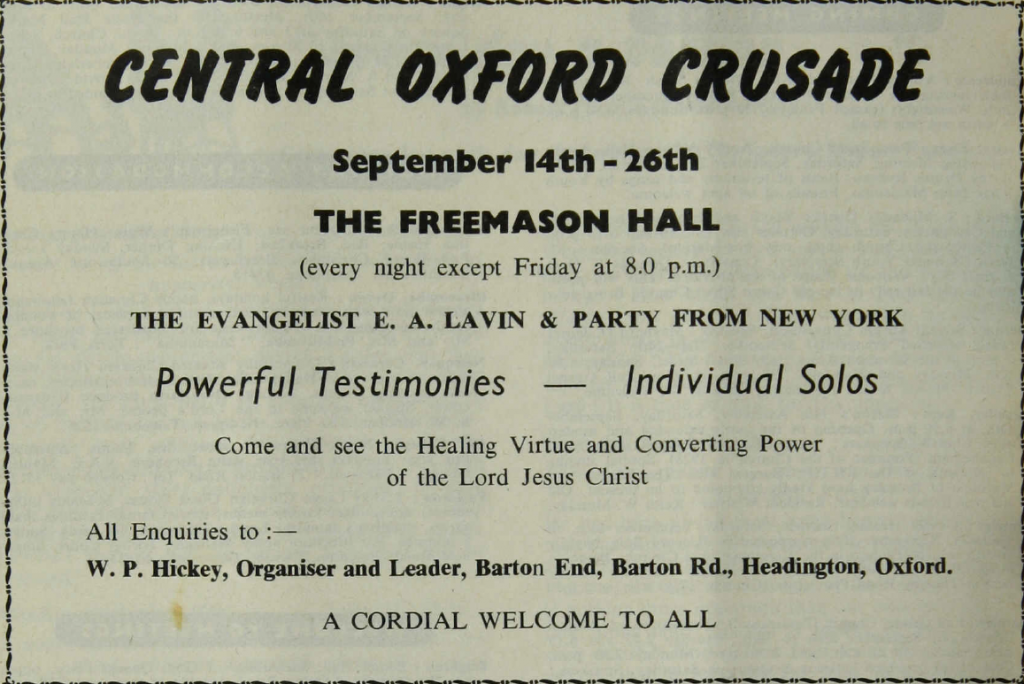
The meetings appear to have been held in the Masonic Centre at 333 Banbury Road, Oxford, where the Oxford freemasons met from 1920 to 2012. Shortly after it closed in 2012, it was described in the Oxford Mail as one of Oxford’s ‘foremost conference venues’, and it was the lack of conference trade that reportedly let to its closure. While it does seem strange to hold the meetings in a place of pagan worship, we may suppose that the conference room itself would have been free of masonic paraphernalia.
There is no report of the campaign in subsequent issues of Redemption Tidings, suggesting that it may have been less successful than hoped for, and Hickey was laid low (RT 27 March 1964, p. 18) from sickness from around December 1963 to March 1964:

By the beginning of 1966 he had left Oxford and was living (RT 7 January 1966, p. 21) in Barking, Essex.
A year after W. P. Hickey’s campaign in the Freemason Hall, a young man called Peter Cox began a year’s service with Assemblies of God Home Missions, along with nine other young people. He is standing second from right in the photo (RT 18 September 1964, p. 6), and Vernon Kinkead (of whom a little more later) is standing next to him furthest right. Cox and Kinkead were both from Ivy Pentecostal Church in Bristol (RT 25 January 1968, p. 9).
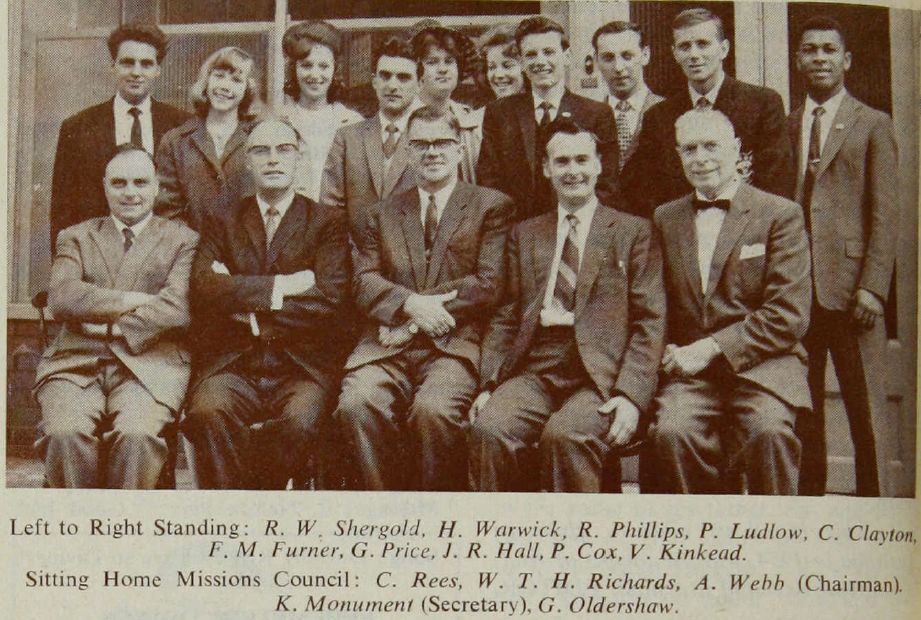
They were to be ready to go anywhere at short notice to distribute leaflets, make personal contacts, help to pioneer or develop ministry to young people and children, and assist with church planting. The common theme was evangelism:

On 31 October 1964, nine of the accepted candidates gave (RT 4 December 1964, p. 15) their testimonies at the assembly in East Ham, London. Cox confessed Christ, and said he was preparing for ministry by seeking the Lord and studying His Word. They had already seen fruit from their evangelistic sowing:


By April 1965, the young gospel labourers had been named ‘heralds’, and their number (RT 2 April 1965, p. 8) had been whittled down slightly to 8. They were all serving in areas away from their own assembly:
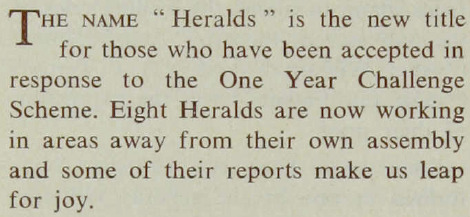
The article by Keith Monument, H0mes Missions Secretary, included reports by two of the heralds, including Peter Cox. He told of three individuals who had come to Christ or received Him as Saviour. One had begun coming to church regularly, and an older lady was meeting regularly with the pastor’s wife:
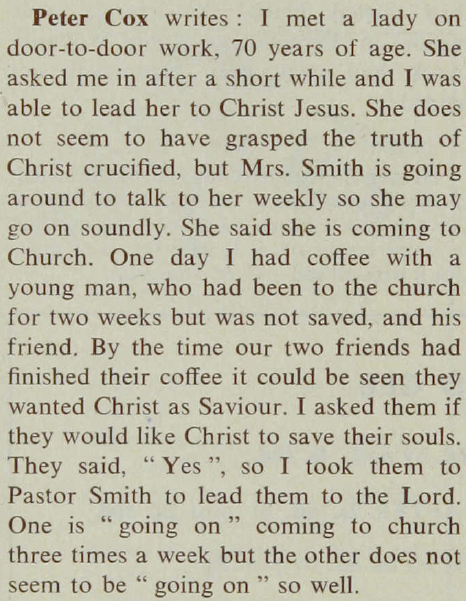
From an item in Redemption Tidings 25 June 1965 (p. 17) we learn that Peter Cox was serving in Fleetwood, Lancashire:
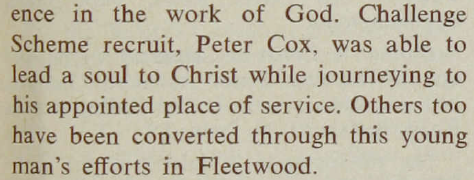
where the pastor of the Full Gospel assembly was Stanley Smith. Later that year, Cox assisted pastor Smith with a youth gospel campaign in Ramsbottom, Lancashire, and gave the following testimony of a definite prayer for the salvation of a soul being answered forthwith:
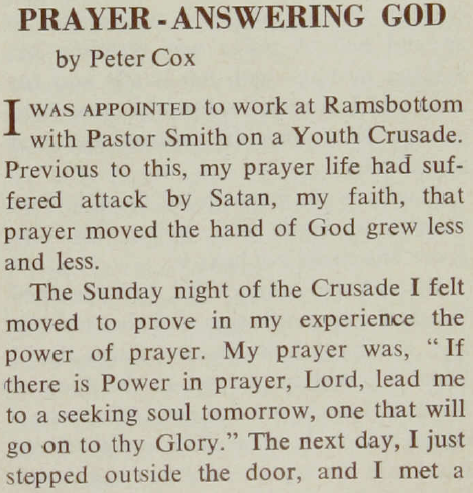

When the year was over, Peter Cox joined himself to evangelist Tom Wilson, to assist him in gospel campaigns (RT 11 February 1966, p. 18; 15 April 1966, p. 18), and in the annual Scarborough camp for young people, which Wilson directed and which lasted eight (RT 2 April 1965, p. 23) to ten (RT 23 December 1966, p. 24) weeks :

Cox gave his testimony (RT 20 May 1966, p. 17) at an Easter Convention (8-11 April 1966) at Bethel Temple, Newport:
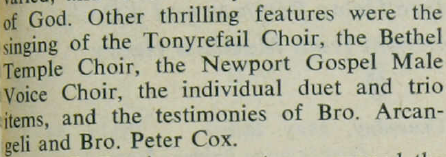
and stayed for a ten day campaign:

Just as the campaign was finishing, Cox appeared (RT 22 April 1966, p. 24) on the programme for the Whit Monday Convention in Trafalgar Square and at Westminster Chapel:
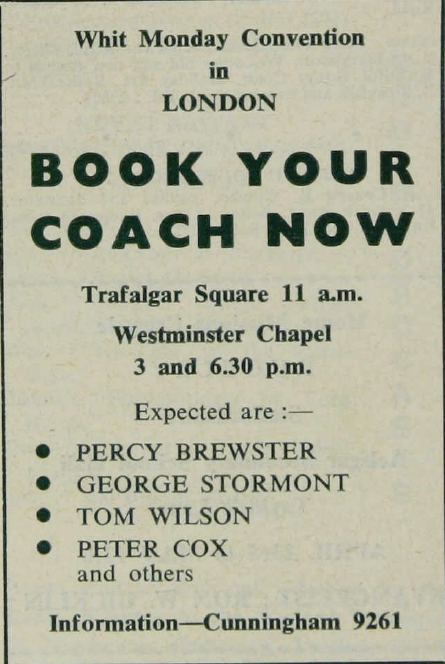
Cox was one of three assistants for another ten day campaign in Wallingford, Berkshire, in October (RT 14 October 1966, p. 11):

According to a local news report, reproduced in RT 25 November 1966 (p. 19), there were nearly thirty decisions to follow Jesus Christ, including probably seven bikers:
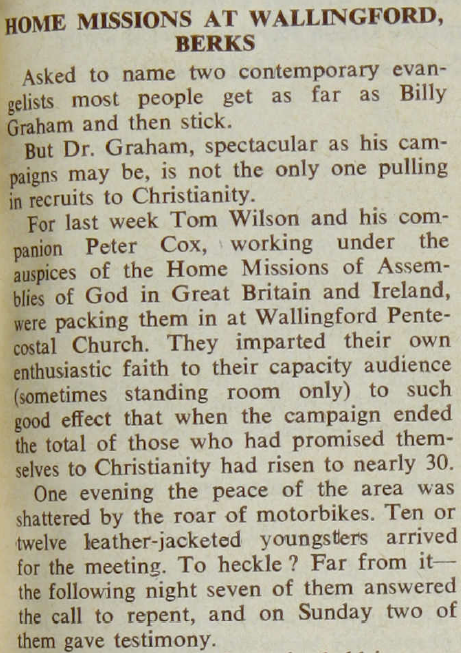
Two weeks later Wilson and Cox were in Ystrad in the Rhondda valley for a 15 day campaign (RT 28 October 1966, p. 24):
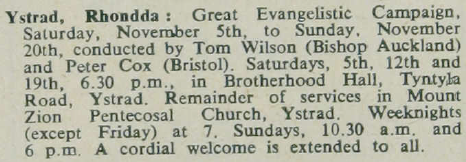
Cox and Wilson campaigned (RT 27 January 1967, p. 22) in Burton-on-Trent in February 1967 for 18 days:

There were five decisions for Christ, and a sister was baptised in the Spirit and spoke with other tongues for the first time (RT 24 March 1967, p. 16):
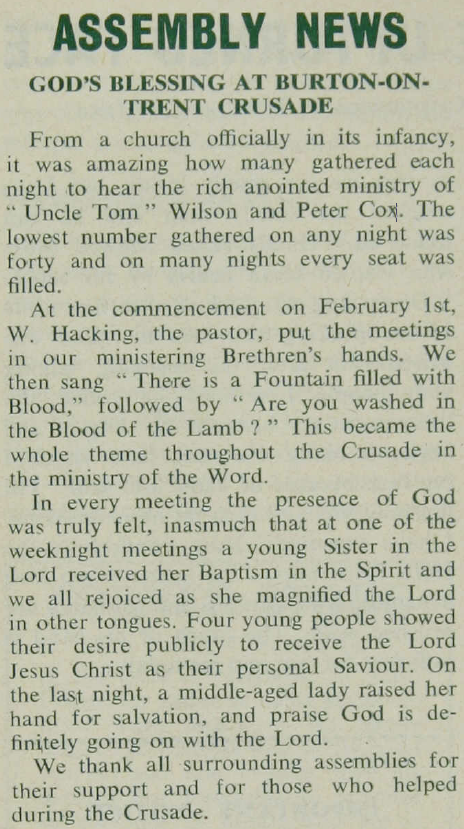
They were in Worksop, Nottinghamshire, in March for 15 days (24 February 1967, p. 22):

and again there were decisions for Christ (RT 21 April 1967, p. 15):
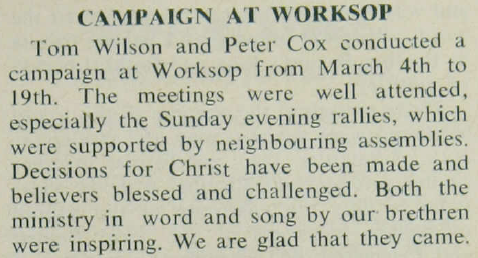
At the AoG’s 44th Annual General Conference, held at Butlin’s Camp, Pwllheli from 13 to 20 May 1967, Peter Cox was granted probationary status as an AoG minister, along with Melvin Banks among others (RT 4 August 1967, p. 19):

The day the conference ended, Wilson and Cox began a 14 day campaign in Manchester (RT 12 May 1967 pp. 21, 24):
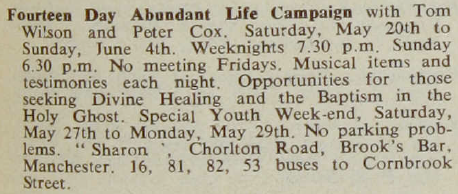
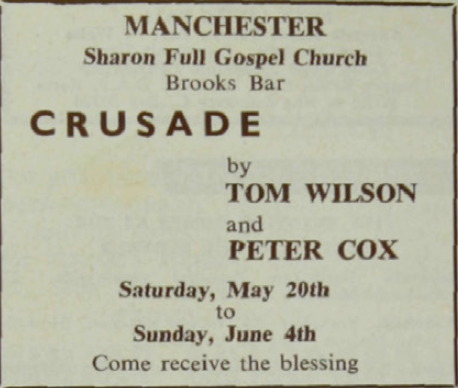
In the last service alone there were more than 30 recorded decisions for Jesus Christ (RT 30 June 1967, p. 19):
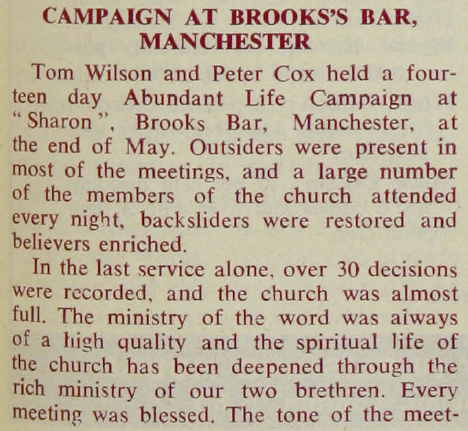
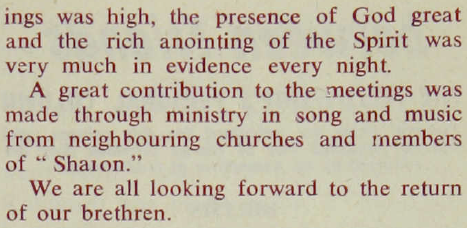
Pioneering in Oxford
Then, in RT 30 June 1967 (p. 14), we learn that Wilson and Cox were separating for the summer period, with Wilson at the Scarborough camp as usual, but Cox to pioneer in Oxford. They were to join together again in October, God willing, for further campaigns:
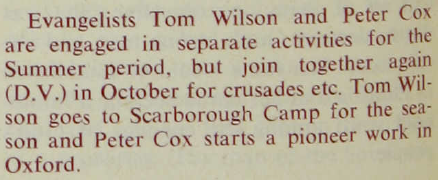
Cox reported later (RT 18 January 1968, p. 14) that the new church opened in June:

In advertisements that appeared in Redemption Tidings towards the end of September (RT 22, 29 September 1967 pp. 22, 23), aimed particularly towards students (with the new academic year about to begin), Peter Cox was named as pastor. The venue was South Oxford Community Centre in Lake Street, and there were two services on a Sunday:

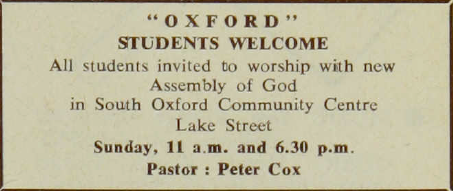
Wilson and Cox did indeed join together again as c0-labourers at a Convention in Swallownest near Sheffield in October (RT 5 October 1967, p. 13):
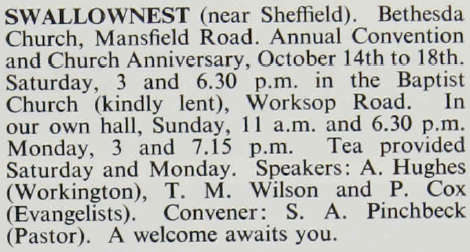
but by December Wilson had Vernon Kinkead as his campaign assistant (RT 30 November 1967, p. 14):

as confirmed in a report in RT 25 January 1968 (p. 13):

Kinkead had assisted Wilson at the Scarborough camp while Cox was pioneering in Oxford (RT 7 December 1967, p. 5):

The above cited progress report from Peter Cox that appeared in RT 18 January 1968 (p. 14) shows that Kinkead had by then spent two weeks in Oxford, co-labouring with Cox, and seeing souls saved and several filled with the Holy Spirit. Howard Carter, towards the end of his long service as a pentecostal minister, had also blessed the Oxford church with his ministry:

and a later visit by Richard Bolt saw a remarkable healing, the operation of spiritual gifts, the salvation of souls, and Christians baptised with the Holy Spirit:

Tom Wilson and Vernon Kinkead conducted a two week campaign in Oxford from 23 March to 7 April 1968 (RT 21 March 1968, p. 13):
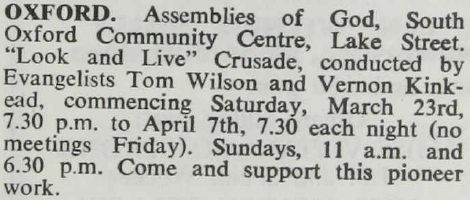
The Oxford church organised a youth camp weekend at Hill End Camp, Oxford in October of that year (RT 26 September 1968, p. 14):
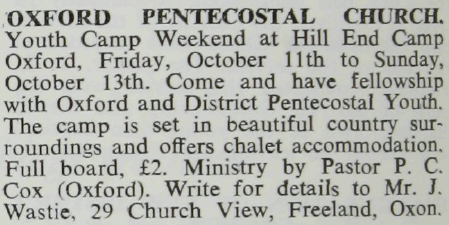
In RT 13 January 1969 (p. 13), pastor Cox was appealing for Christian books to furnish an assembly library:

At the 1969 General Conference held from 10 to 17 May in Bognor Regis, the Oxford assembly was admitted into fellowship with the Assemblies of God:

and Peter Cox became a Full Minister:

He was a guest speaker for two youth weeks for the 1969 Scarborough Camp (RT 31 July 1969, p. 14):
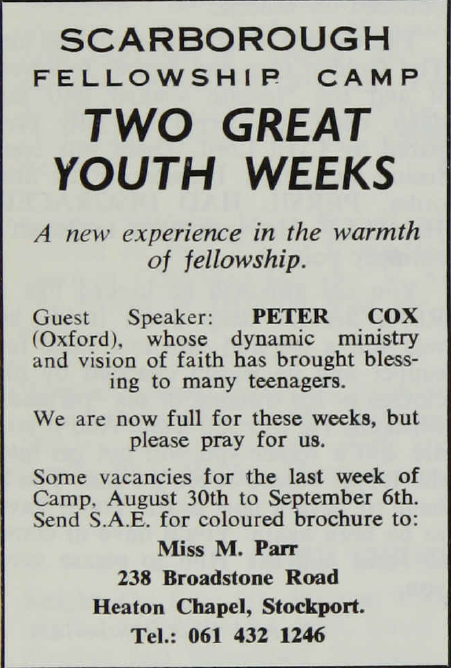
RT 7 August 1969 (p. 12) carried a summary of the progress so far of the Oxford assembly. There were now forty to fifty breaking bread together on Sunday mornings. About twenty were attending an outreach service in Punjabi on Sunday afternoons. Once a fortnight there was an evening evangelistic outreach, the evening gospel service continued, and there was ongoing door to door work. In May, two hundred (including some from neighbouring assemblies) had attended a rally for the deepening of spiritual life, with John Carter ministering:
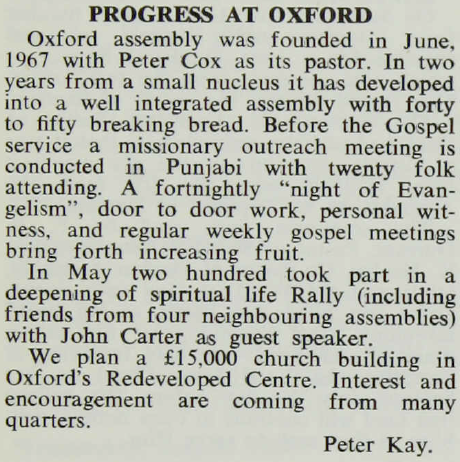
Conclusions
The Oxford assembly had thus been firmly established, two years after Peter Cox had begun to labour there. If he had been, say, 22 when he began service as an AoG ‘herald’, then he would have been around 25 when he came to Oxford. There is no indication that he had studied at bible college. Rather, the three years prior to planting the Oxford assembly were devoted primarily to church-based evangelism, first attached to one or more local churches as a ‘herald’, and then assisting Tom Wilson in his town and city campaigns, as well as with the Scarborough Camp.
He would have sat under a great deal of gospel preaching, and learned first to give his testimony in public meetings, followed one imagines by gradually stepping into preaching sometimes himself. He would have partnered with many churches and many pastors as a herald and then in the campaigns, and gained a great deal of experience of church life and local missions in a short time. With Wilson, he would have encountered many difficulties and discouragements and learned to pray through and trust God unto victory. Above all perhaps, his experience would have been as much with unbelievers as with believers, and he would have learned how to conduct gospel services in a way appropriate to the needs of unchurched people. All this, it seems to me, is very good preparation for church planting, and merits reflection by those with responsibility for the training and preparation of gospel and church ministers.